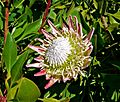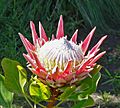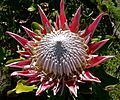Protea cynaroides facts for kids
Quick facts for kids Protea cynaroides |
|
|---|---|
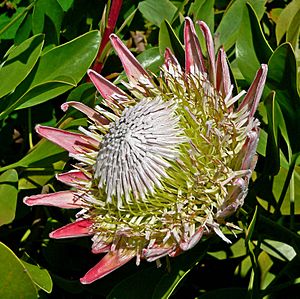 |
|
| Conservation status | |
| Scientific classification | |
| Genus: |
Protea
|
| Species: |
cynaroides
|
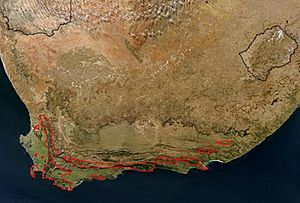 |
|
| Synonyms | |
|
|
The Protea cynaroides, often called the king protea, is a beautiful flowering plant. It's famous for having the largest flower head in its group, Protea. People also know it as the giant protea, honeypot, or king sugar bush. You can find it mostly in the southwestern and southern parts of South Africa, in a special plant area called fynbos.
The king protea is very important to South Africa. It is the country's national flower. It also helps with the Protea Atlas Project, which studies these amazing plants.
King proteas come in many colors. Plant experts have found 81 different types that people grow in gardens. Some types have creamy yellow flowers instead of pink, and their leaf edges are yellow instead of red. This unique flower lasts a long time in flower arrangements. It also makes a great dried flower.
The king protea can survive wildfires. It has a thick underground stem with many hidden buds. These buds grow into new plants after a fire.
Contents
Plant Family and Name
The king protea belongs to a huge plant family called Proteaceae. This family has about 80 different plant groups, called genera, and around 1600 types of plants, called species. These plants are mostly found in the Southern Hemisphere. You can see them in Southern Africa, Australia, and South America. Some are also in other warm parts of the world.
The name of the plant family, Proteaceae, and the group Protea come from an old Greek god named Proteus. This god could change into many different shapes. This name fits well because the plants in this family have an amazing variety of flowers and leaves.
The second part of the king protea's name, cynaroides, means "like an artichoke." This is because its flower heads look a bit like an artichoke. Artichokes belong to the plant group Cynara.
What the King Protea Looks Like
The P. cynaroides is a woody bush with thick stems. It has large, dark green, shiny leaves. Most adult plants grow to be about one meter (around 3 feet) tall. But they can be anywhere from 0.35 to 2 meters (about 1 to 6.5 feet) tall. This depends on where they grow.
The "flowers" of the king protea are not just one flower. They are actually many small flowers grouped together. This group is called an inflorescence. These tiny flowers are in the center. They are surrounded by large, colorful leaf-like parts called bracts. These bracts can be from 120 to 300 millimeters (about 5 to 12 inches) wide.
Strong, healthy plants can grow six to ten flower heads in one season. Some special plants can even grow up to forty flower heads! The color of the bracts can be anything from creamy white to a deep red. But the soft, pale pink ones with a silvery shine are the most popular.
How King Proteas Live and Grow
Protea cynaroides grows in a tough environment. It has dry, hot summers and wet, cold winters. The plant has special ways to survive. Its leaves are tough and leathery. This helps them not lose too much water. It also has a large taproot that goes deep into the soil. This root helps it find water underground.
Like most other Proteaceae plants, the king protea has special roots called proteoid roots. These roots have dense groups of short, tiny roots. They form a mat in the soil just under the fallen leaves. These roots help the plant get nutrients from the soil. This is important because the soil in its home, the fynbos, does not have many nutrients.
Pollination and Animals
Many birds that eat nectar visit the king protea's flowers. These include sunbirds and sugarbirds. Some examples are the orange-breasted sunbird, the southern double-collared sunbird, and the Cape sugarbird. To get the nectar, a bird pushes its beak into the flower. As it does this, pollen sticks to its beak and face. This helps the plant spread its pollen and make new seeds.

Besides birds, many insects are also drawn to the flower heads. These include bees, like the Cape honeybee. Various types of beetles also visit, such as rove beetles and scarab beetles. The protea beetle Trichostetha fascicularis and monkey beetles are some examples.
Surviving Wildfires
Like many other Protea species, the king protea is made to live in places where bushfires happen often. These fires are actually important for the plant to reproduce and grow new plants.
Some Protea plants are "reseeders." This means the fire kills them, but it also makes their seeds open up. These seeds then grow into new plants. Other Protea plants are "resprouters." They survive the fire by growing new shoots from a special underground stem called a lignotuber. The king protea is a resprouter. After a fire, it grows new stems from the buds in its thick underground stem.
King Protea in Sport
Since the king protea is the national flower of South Africa, it gives its name to the national cricket team. Their nickname is "the Proteas". In the early 1990s, there was a discussion about whether the flower should be put on the national rugby team's shirts. Some thought it might replace the springbok symbol.
Gallery
Images for kids
See also
 In Spanish: Protea rey para niños
In Spanish: Protea rey para niños






